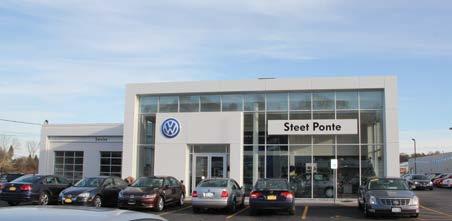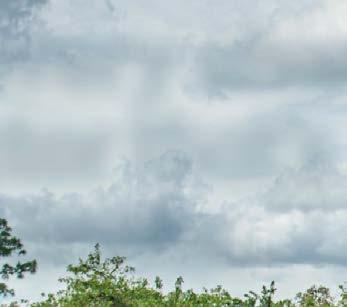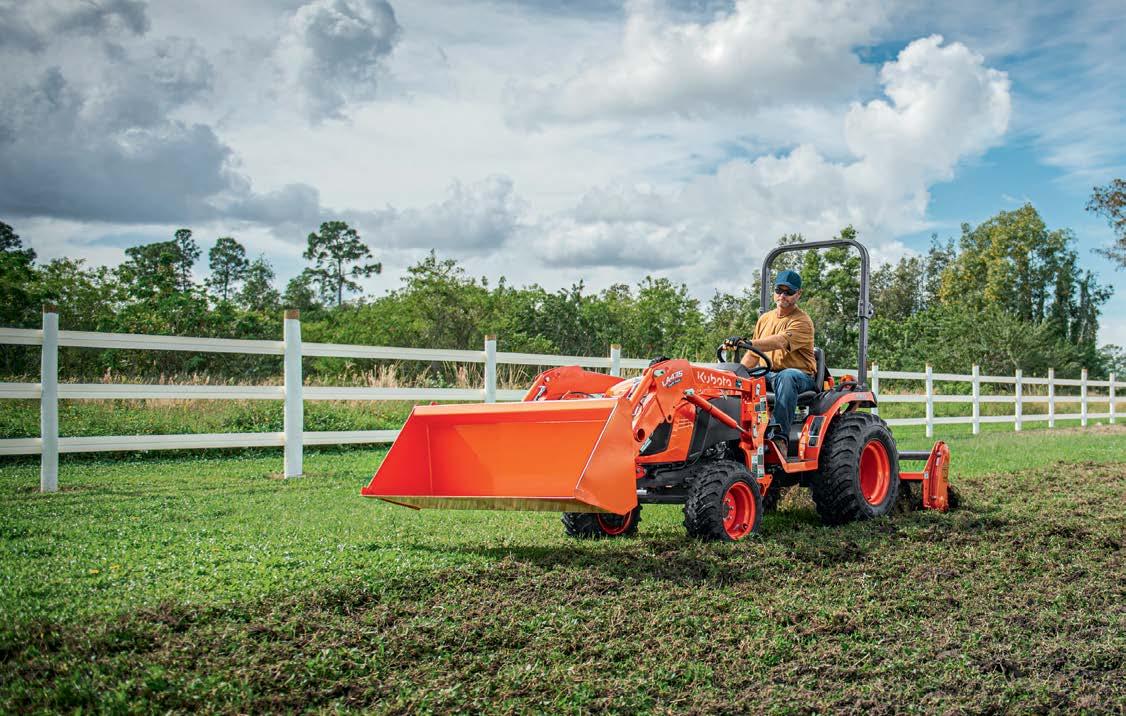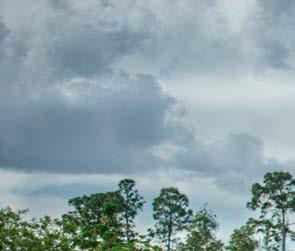

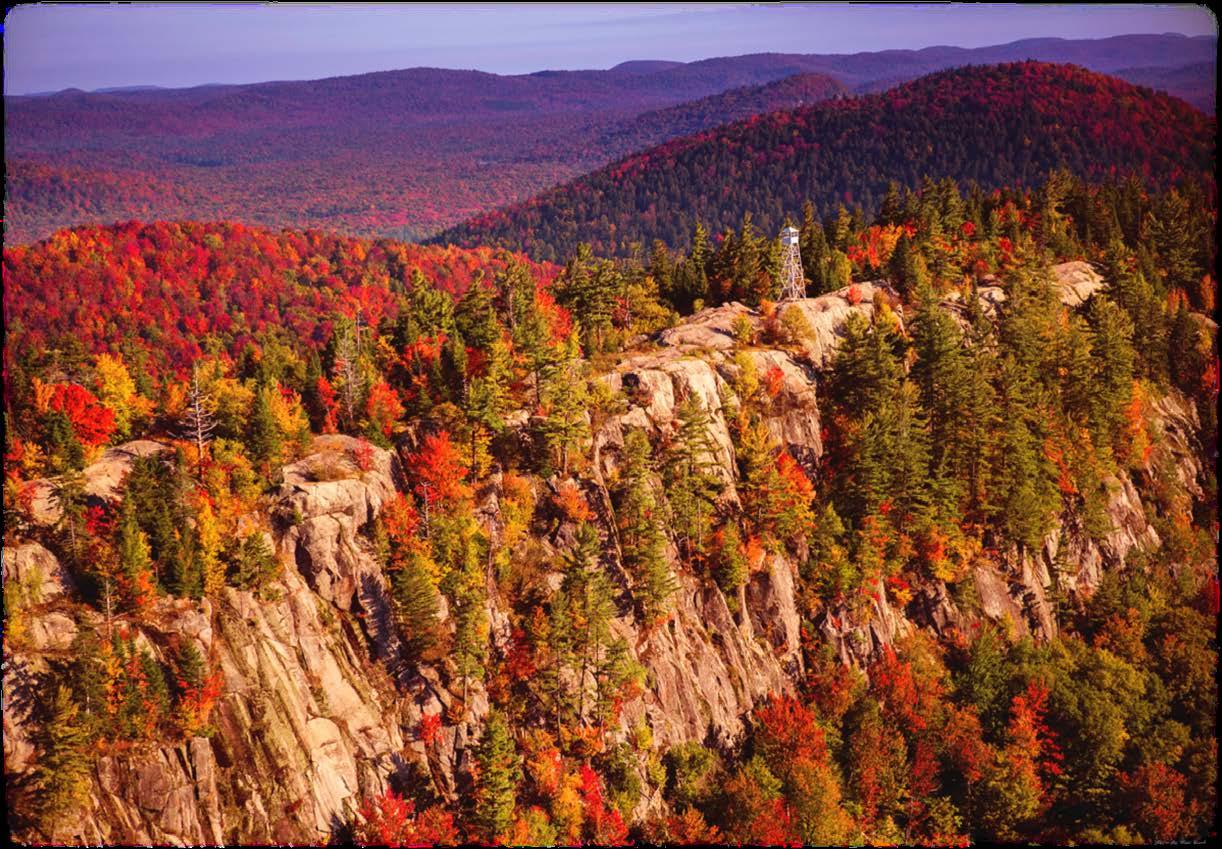


















































































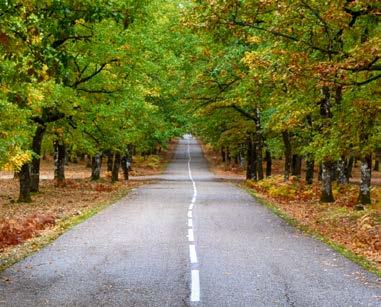
 by Sharry L. Whitney
by Sharry L. Whitney
Every month I have the privilege to write my editor’s note and publicly ponder whatever is on my mind. The response last month to my intro, “The Dream,” has made me realize I’ll have be more careful. I must have sounded pessimistic because we started receiving encouraging letters, calls, and emails from concerned readers. In my writing, I openly lamenting about losing some of our creative freedom because of the current high cost of paper. I was commiserating with other small businesses and the “tightening of the belt” we all have to deal with right now.
Have no fear, MVL is going strong, and we are looking forward to and making plans for our 18th year in business! Many of our current advertisers have been with us for this entire “Road Trip,” and we are receiving calls from new advertisers more than ever before! (see if you can find the new ones!)


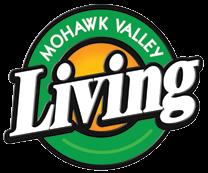
So, to answer all those thoughtful people ask ing what they can do “to help,” I’ll give the same answer I always give (though maybe not often enough). Please visit and shop our advertisers. Don’t thank us, thank them, because even though they are tightening thier belts too, they are still here in the pages of MVL supporting what we do and making the dream possible. •
and Sharry Whitney Whitney David MalenowskiValley Living







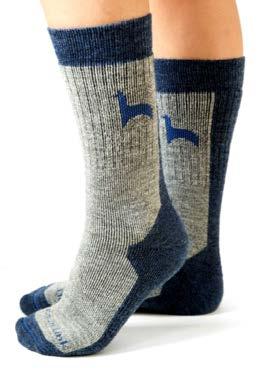






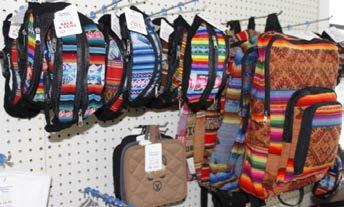






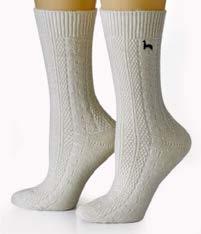
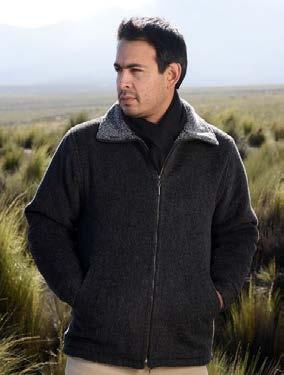
A


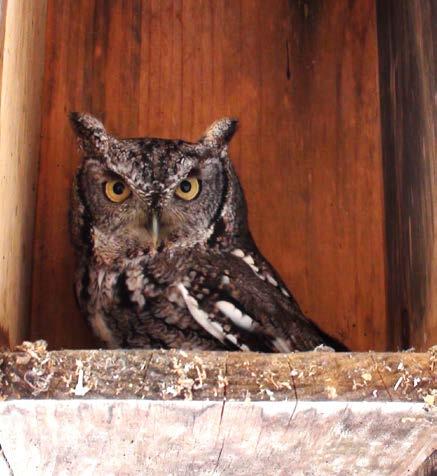

A great way to attract birds to a proper ty is to provide them with housing. This can simply entail leaving them habitat; allowing them the raw materials and edifices they need to create their housing. For cavity-nesting birds, this would mean leaving dead trees or dead parts of living trees for them to excavate their homes into. Over the years, at the nature sanctuary, we’ve tried to make up for a lack of standing dead trees by erecting nest boxes wherever needed. Most of the boxes we have put up were designed to be used by Eastern Bluebirds, but we’ve also put up nest box es of other shapes and sizes to cater to other bird species. The largest boxes are meant for American Kestrels, Eastern Screech Owls, and Wood Ducks. The smallest are intend ed for Black-capped Chickadees and House Wrens.
No matter what bird species a nest box is designed for, they are not species specific. They are not even bird-specific since small mammals can utilize them too. In the North eastern US, the standard bluebird box design with a 1.5-inch diameter entrance hole is reg ularly used by Tree Swallows, House Wrens, House Sparrows, Black-capped Chickadees, and Tufted Titmice. Great Crested Flycatch ers and White-breasted Nuthatches may also use them on occasion. White-footed Mice of ten inhabit Bluebird boxes, although primar
ily during the winter season. Sometimes a mouse will contin ue to inhabit a box in spring when their use overlaps with the breeding season of some of the earlier nesting songbirds. Flying Squirrels oc casionally inhabit Bluebird boxes when they are placed in a more wooded set ting. Red Squirrels will sometimes take over a bluebird box, but only when they can widen its entrance hole. Using their teeth, Red Squirrels plane the wood in the interior of the box to increase their living space. The wood shavings from their work are then incorporated into their nest mass, which is otherwise constructed of bark strips.
Generally, when it comes to attracting specific bird species, the placement of a box is just as important as the box’s inner di mensions and the size of the entrance hole. Boxes mounted in an open meadow or in and around a marsh are much more likely to at tract bluebirds and swallows than nest boxes
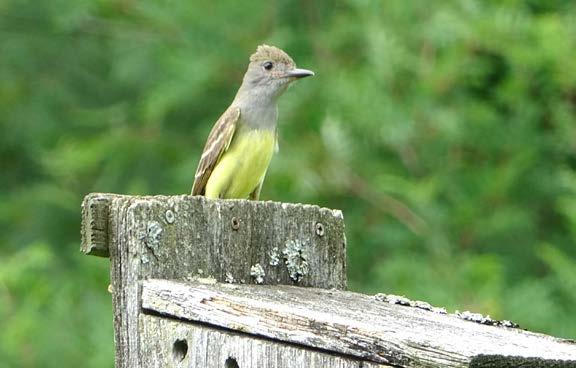
placed in a wooded area. Boxes placed in the woods are more apt to be adopted by titmice and boxes mounted in woodland adjacent or brushy areas are more attractive to chicka dees and wrens.


When selecting or building a bird nest box, design is a crucial consideration. There are many books and online resources which provide design details, so I will only make some general suggestions that apply to vir tually all nest box types. Most crucially, be sure your box can be opened for cleaning. A good box will open from a side or front pan el, and some open from the roof. The box’s




door should be able to close securely so that it doesn’t inadvertently open while birds are nesting. Sometime following the nesting sea son and before the next season begins, the box should be emptied and all old nesting material removed. Boxes that are unopenable tend to become packed with material and are soon rendered unusable by birds. One should always wear a mask and gloves when clean ing out bird boxes.
Refrain from painting your boxes – paint may outgas on hot days and the fumes could be toxic to your bird tenants. If you do use a painted box, be sure it is painted in a light color that won’t absorb the sun’s rays. Over






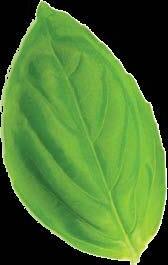

heating inside a nest box can kill young nestlings. Ventila tion is also very important as it helps mitigate the effects of the summer heat. If your boxes lack ventilation, a row of quarter-inch holes drilled along the top of the side panels would be an easy fix. Also, if your box lacks drain age holes, a couple of lines of holes drilled into the base of the box make for a quick solution.
In the wild, a high propor tion of bird nests are pilfered, and the young or eggs are taken by nest pred ators. Cavity nesting birds tend to fare better than birds that use open nests, but they are by no means invulnerable. A weak box can be broken into by a determined attacker. This year, a raccoon tore the top off one of our old er nest boxes to get at the Tree Swallows that were nesting inside. Old brittle boxes or ones that are generally not sturdy will not stand up to an attack or even to sustained exposure to the elements. Certainly, no box lasts forever, and repair or replacement may be necessary after several years of service.
The way a box is mounted also contrib
utes to its vulnerability to predation. A box affixed to a tree or wooden post will be sub ject to the most predator traffic since wood is easy to climb. A metal post is trickier to scale, and it tends to discourage predation from raccoons. Of course, some forms of nest box predation cannot be guarded against. About a decade ago, I saw an American Kestrel preying on Tree Swallow nestlings. The kes trel would arrive at a nest box like a parent returning with food. When a nestling came to the entrance hole to receive its meal, the kestrel would grab it and fly off.
Some nest boxes have perches affixed just below the entrance hole. Although such a fea ture seems like it would be a help to the nest ing birds, it is not necessary and can even be detrimental. If the box you are putting out for your birds has a perch, it’s best to remove it. When constructing a birdhouse, it’s advisable to use wood that has one rough or un-sand ed side. The rough side should become the walls of the cavity. Nestlings can then get a better grip and thereby stand a much better chance of climbing the walls and exiting the box come fledging time. Their climb can be further assisted by etching a row of groves on the inside wall between the floor and the entrance hole, thus making a ladder. A ladder can also be made by cutting a piece of plastic

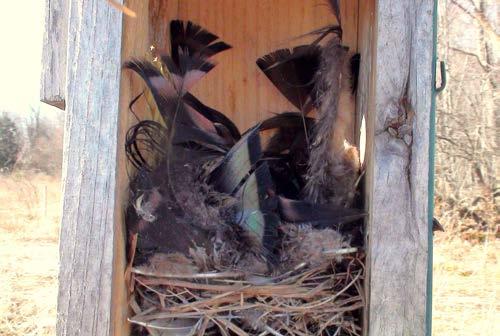
or metal mesh and stapling it flush against the wall be tween the floor and the entrance hole.

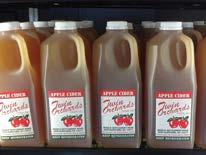




Bird nest boxes are often inhabited by Paper Wasps and their small gray nests typically festoon the interior ceil ing –sometimes resembling paper chandeliers. As far as I could determine, the wasps seemed to coexist with the birds. I’ve never seen evidence of birds evicting wasps from their nests, nor have I encountered instances of wasps attacking and stinging the resident birds. Wasps are not the only insect species that take up residence in bird boxes, sometimes ant colonies do as well. I haven’t encountered any instance in which an ant colony at the bottom of a nest box caused harm to chicks or eggs, but I have noticed that birds tend to avoid starting a nest in boxes with established ant colonies.

Every late winter/early spring we clean out our bird boxes. Far from being a mundane task, we look forward to it since when cleaning we get the opportunity to find out what happened during the previous nesting season. Indeed, based on the construction style of the nests with in the boxes, we can determine what species were using them. Sometimes I term this activity “nest box archaeol ogy” since it entails sorting out nests layered upon other nests. That occurs when multiple birds use the same box in a single season; each building its nest on top of that of its predecessor. Fairly often, the nest on top is an active (or recently abandoned) White-footed Mouse nest. The
 Tree Swallows frequently use bluebird boxes
Tree Swallows frequently use bluebird boxes
mouse also has a distinct construction style that is easily recognizable from that of birds. Examining the nests, it is possible to know which ones were used successfully to raise young based on the amount of fecal material deposited by nestlings. A well-used nest ap pears battered down and liberally anointed with grayish droppings. On the other hand, nests that were raided or abandoned before any young were reared may appear pristine. Occasionally, unhatched eggs are found in the old nests. These were either infertile and
didn’t hatch with the rest of the clutch or the parents abandoned the site.












Recognizing the differ ent nest designs birds use is not difficult. Tree Swallows and bluebirds make cup-shaped nests comprised of grass and other fine materials. Some times a bluebird will use soft pine needles instead of grass. Tree Swallows almost always incorporate some feathers into their design although their use is more decorative than func tional. While some individual Tree Swallows use only a few feathers, others (presumably older and more experienced birds) will use a dozen or more. House Sparrows typically use grass to make their nests. Their nests are woven structures that incorporate some small feathers and fea ture an incomplete woven canopy. House Wren nests are built on a haphazard platform of twigs. Recessed into the bed of twigs is a small cup-shaped nest of grass, rootlets, and other soft fibers. This is where the young are reared. Like the nest of the wren, the nest of the Black-capped Chickadee stands out from
the standard grass nests. They make a mat tress-like bed of moss and fur which covers the entire floor of the box. Recessed in the center of the bed is a cup-like depression and that’s where the eggs are laid. Of all the dif ferent nest styles, the chickadee’s nest looks the most comfortable.

Putting up nest boxes is a wonderful and simple way to provide housing for wildlife and foster successful breeding for native birds. It also allows us to view nesting behav ior close-up. Bird boxes appropriately placed are often adopted quickly – many within a year of being mounted. For those of us in the habitat creation business, that’s tantamount to instant gratification. So, whether you pur chase bird boxes or build them yourself, put some up on your property and see what hap pens. You may just be pleasantly surprised. •
Matt Perry is Conservation Director and Resident Natu ralist at Spring Farm CARES in Clinton. He manages a 260 acre nature preserve which is open for tours by appointment. His nature videos and photos can be found on the Spring Farm CARES’ Nature Sanctuary Facebook page.


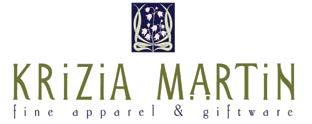

Although fennel is a member of the carrot family, it’s not consid ered a root veggie. The large bulb grows above ground with stalks that resemble dill with yellow blooms.
Indigenous to the Mediterranean, fennel has naturalized in many parts of the world, especially places with dry soil near sea coasts and riverbanks.
There are two types of sweet fennel. Foeniculum vulgare is the common herb type known for the anise flavor of its leaves and seeds. The second type is Florence fennel, also known by its Italian name, finocchio.
The herb type grows 3-4 feet tall with finely textured foliage resem bling dill. Clusters of flat-topped yellow flowers appear in late sum mer. Stems, leaves, and seeds of this type can be harvested. Florence, or bulbing, fennel (f.vulgare var. azoricum) is shorter with darker green foliage. It is grown for its large, thick bulbous base. Both forms have the anise, or licorice, flavor.
Bronze Fennel (f. vulgare ‘rubrum’) is typically grown as an annu al. It goes well with fish dishes, especially salmon. It provides a unique anise flavor and is one of the main ingredients in Italian sausage. You can use bronze fennel and green fennel interchangeably in dishes. Bronze fennel is a beautiful addition to your garden and makes for a nice backdrop. This is a host plant for eastern black swallowtail and anise swallowtail butterflies, providing food, shelter, and protection for these pollinators and their young.
The plant prefers a warm, dry climate with soil that isn’t too acidic. However, it can survive in a variety of climates.
Start seeds indoors in early spring, about 8 weeks before last frost. Plant after frost danger has passed. Fennel likes fertile, well-drained soil. Bulb fennel must have moisture so plant it near access to water.
Mix an application of a balanced organic fertilizer into the soil before planting. Space plants 12 or more inches apart.
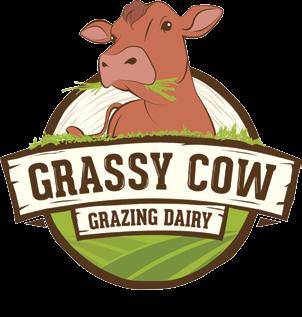
Start seeds for fall planting of bulb fennel in midsummer, and set them out about 8 weeks before the first frost date for your location. Harvest bulbs before the first hard frost.
Fennel seeds can be sown directly about three weeks before the last spring frost date.

Herb fennel is grown just like bulb fennel, one or two plants is usu ally enough for most families. Fennel plants grown for the fronds and seeds grow to about 5 feet and are best situated in the back of the gar den.
Harvest fennel bulbs that are more than 2 inches in diameter when you want to use them in the kitchen. Bulb fennel plants grown in spring do not get extremely large and should be harvested before the weather turns hot. If you can cut the bulb high, letting the root and base of the bulb remain in the soil, the stub will regrow a few small crowns with miniature fennel fronds you can use in dishes.
With half of the tops trimmed off, fennel bulb will keep in plastic bags in the refrigerator for a couple of weeks. Excess bulb fennel can be blanched and frozen.
I first learned about fennel when I married my first husband. His family always had finocchio. It was always a part of our thanksgiving and Christmas feasts. It was always reserved for very special family gatherings. To be honest, I am not of fan of the traditional roasted fen nel we had at those celebrations and couldn’t fathom the delight they all had at seeing it on the table. It wasn’t until my next life with Bernie growing veggies for our CSA on our farm that I began to appreciate fennel and use it in recipes for our shareholders. I find I prefer it raw and I will be sharing with you a wonderful winter salad for you to serve to your family.
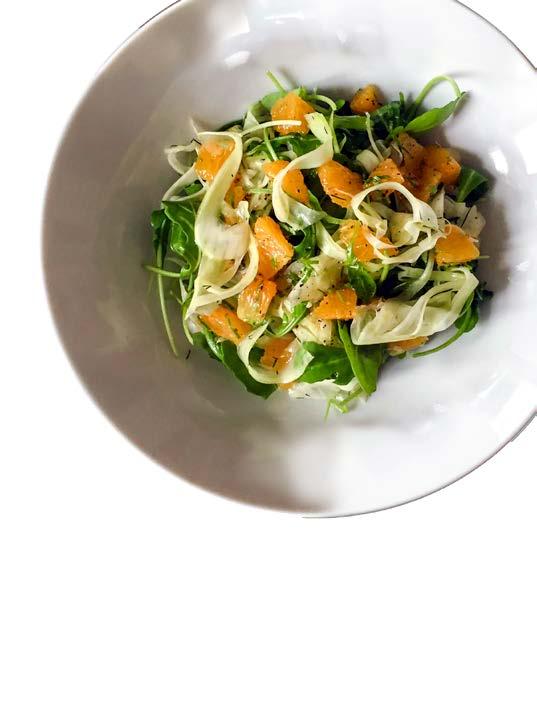 By Three Goat Farm-CSA
By Three Goat Farm-CSA


1 bulb of Fennel
1 navel orange

1 small red onion
Fresh basil
Kosher salt





Extra virgin olive oil


Located
Begin by washing the fennel and removing fronds. Chop up two Tbs. of fronds and set aside for later.

For this salad, I peel the fennel rather than chop it. I prefer this salad to have thin ribbons of fennel throughout; it makes the salad easier to eat, and allows the flavors and dressing to permeate the fennel. To get the ribbons, I use a potato peeler, but you could also use a mandolin.
Place the ribbons of fennel in a bowl and toss it with tsp of kosher salt. Let the fennel and salt sit for at least an hour to allow the juices to be pulled from the fennel. This will create a dressing with the other ingredients. This is the key to this salad; the fennel and the salt naturally cre ate the perfect base to build a dressing on. While the fennel and salt are resting, prepare the rest of the ingredients for the salad.
Start by zesting, peeling, and cutting the orange into segments. Then, thinly slice a medium red onion, and chop 2 Tbs. of fresh basil.
After the fennel and salt have rested an hour, mix it with the red onion, orange segments, orange zest, basil, fennel fronds, and olive oil.
Enjoy!

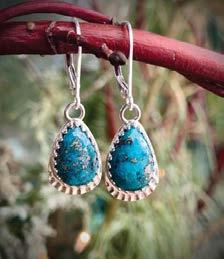




Beatrice “Bea” DeSantis has been described as “a woman before her time,” and “always a force to be reckoned with.” She was a public servant, pioneer, and leader whose gender never stood in her way of making a difference in her community.
Bea was born in Utica in 1900 and graduated from Utica Free Academy in 1918. She continued her education at Utica School of Commerce and worked at New York Telephone. During World War II, Bea worked long hours doing her part on the home front assembling and dispersing rationing books to the citizens of Greater Utica for the Office of Price Administration.
After the war, Bea served the City of Utica for more than 25 years. She began working as secretary to the City Treasurer, was a Cashier, became the second woman to hold the position of Deputy Treasurer, and finished her career as Secretary to Utica’s Commissioner of Assessments and Taxation.


Bea’s involvement in the Utica Democratic party began in 1936. She started as a ward committeewoman and ascended the

become a presidential


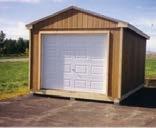
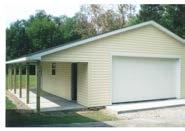

Senator George McGovern
In between, she was actively involved in the East Utica Democratic Women’s Club, the East Utica Democratic Organization, the International Alliance Club, the Young Democratic Club of Oneida County, and the New York State Democratic Party. In the mid-1980s, Governor Mario Cuomo appointed her to his Advisory Committee of the New York State Office of the Aging.

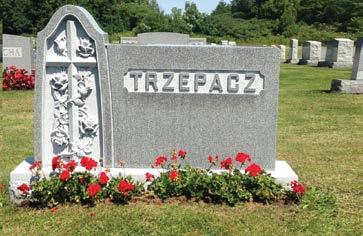


Bea was an active volunteer in the local community and beyond. She was a founding member of the East Utica Senior Center and the first Heart Fund collection in Oneida County, the forebear of today’s Central New York Heart Association. She shared her time with numerous organizations including the League of Women Voters, the American Cancer Society, and cultural groups such as Daughters of Columbus, and Utica’s Society Pugliese.

Bea’s time and talent were appreciated by many. At a dinner in her honor in 1972, Mayor Michael Caruso said: “there is no more intense or dedicated opponent than Bea DeSantis – and no more gracious lady.” Bea, appreciative of the kind words, summed up volunteering by saying “you find the time to help out.” Beatrice DeSantis passed away in 1991 and is buried in Calvary Cemetery in South Utica.
Bea will be honored and inducted into the Oneida County Historical Hall of Fame on October 26, 2022, for her contributions to our community and beyond. The public is invited to attend the induction celebration. More information about the celebration and tickets can be found on oneidacountyhistory.org. •
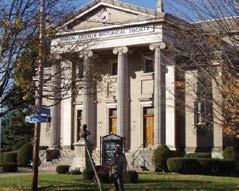








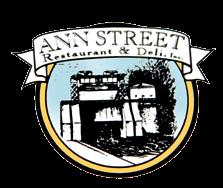


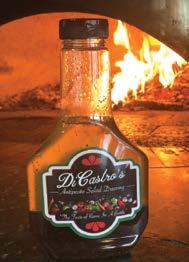







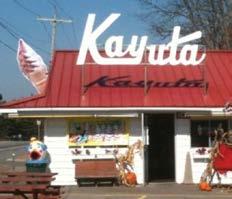











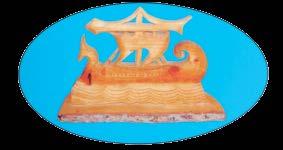




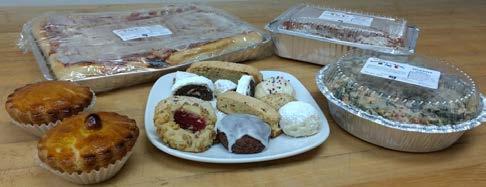

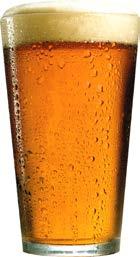

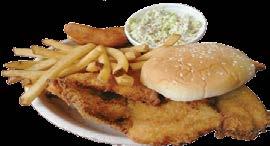








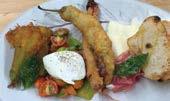



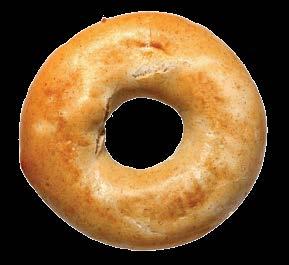




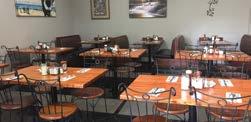


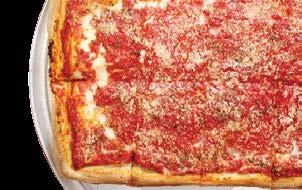





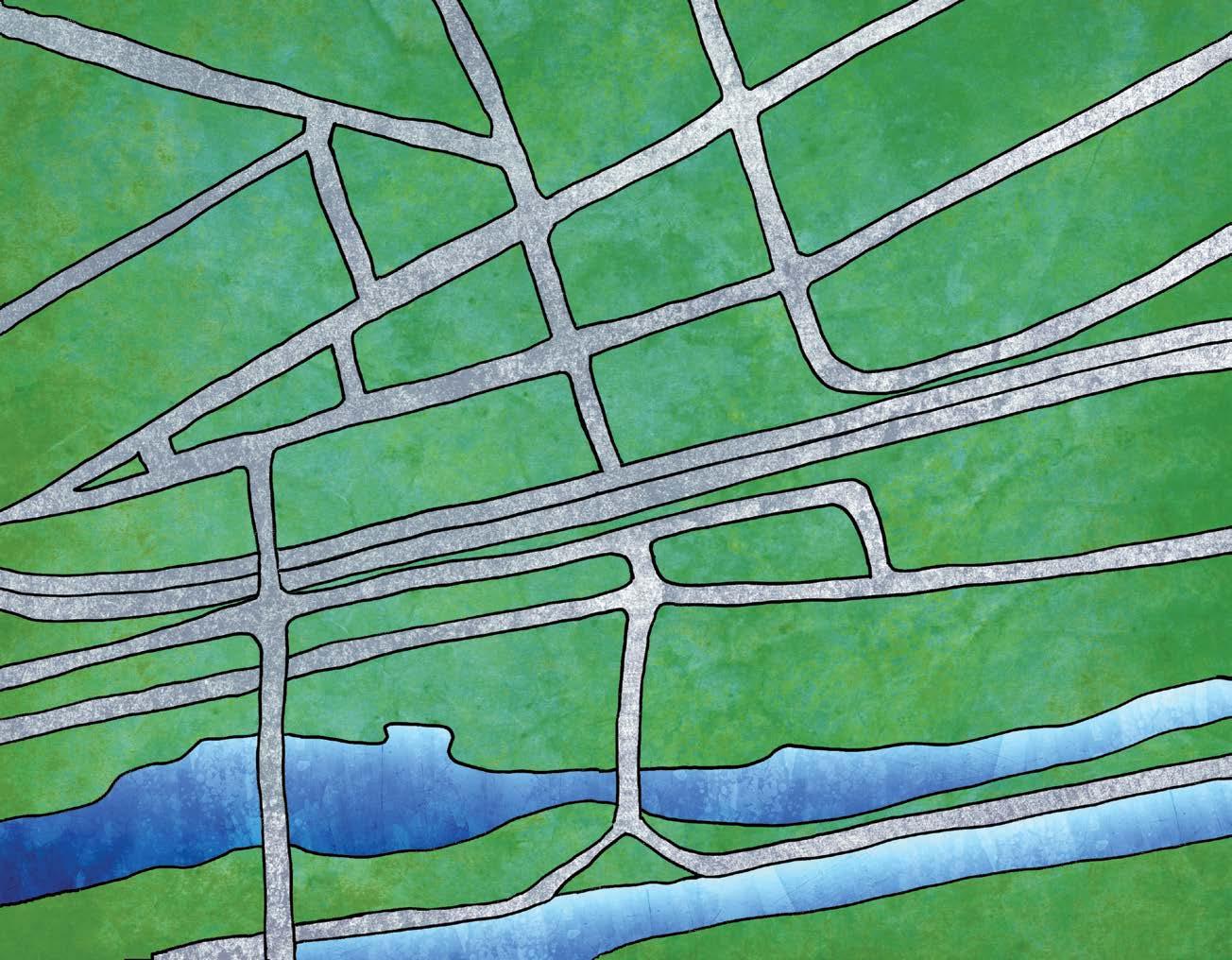




















































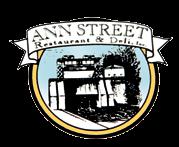






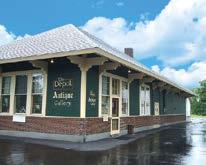


















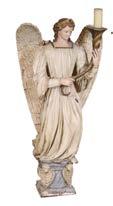





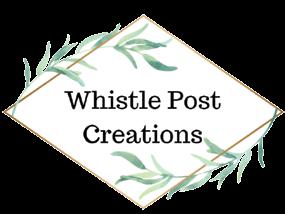


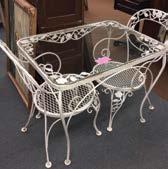
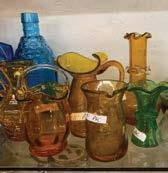




October is a wonderful month to expe rience nature in the Mohawk Valley. The changing foliage provides a vibrant backdrop for the drama that takes place on land, in the sky, and on the water. By October, songbird and waterfowl migration is in full swing and can be viewed from almost anywhere good habitat is found. Of course, there are other things to see as well. There is the food cach ing behavior of forest-living rodents, primar ily squirrels and chipmunks. These ubiqui tous animals scour the branches of nut and seed-bearing trees for every edible morsel. High in the tree canopy, a squirrel will cut loose dozens of nuts, allowing them to fall to the forest floor. Later, he will scramble down the tree trunk to collect them from the ground. In a woodland heavily populated by oaks, hickories, and/or beech trees, you may hear the near-constant sound of nuts pelting the ground as squirrels work the tree canopy. The collected food will then be stored in secret food caches in the ground or in tree cavities. This harvest is what squirrels will draw on during the long winter months. Most squir rels will switch residences at this time of year. In October, Gray Squirrels abandon their leaf and stick constructed nests in the treetops in favor of less obvious and more weather-resis tant tree cavities. Indeed, as the tree branches lose their leaves, suddenly all their nests in the tree canopy become obvious. Just as they are

obvious to us, they are also obvious to predators. This provides the squirrels with great incentive to move to less conspicuous lodgings.
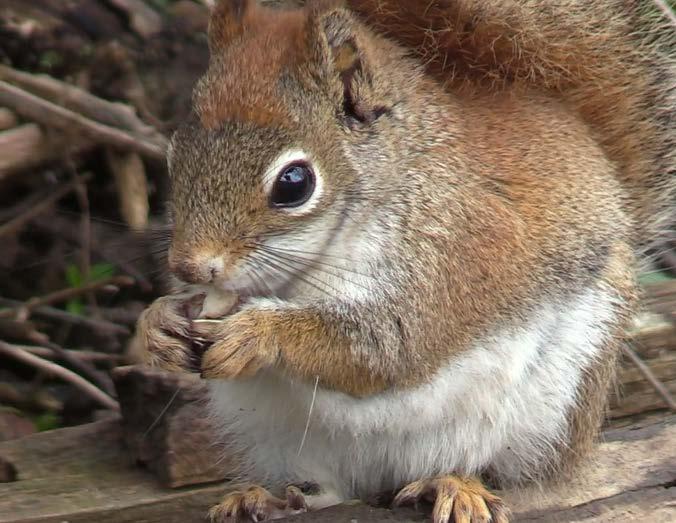
In October, large flocks of Canada Geese noisily traverse the sky, often landing on ponds, open wetlands, and cut corn fields. On some of our local ponds, we may encounter thousands of geese as they pause on their journey to rest and feed. On larger bodies of water, the geese may share space with a diverse group of other migrant waterfowl, including ducks, grebes, coots, and loons. American Coots are the size of small ducks. They are mostly dark gray and have pale bills. Coots make their living by diving underwater to feed on aquatic plants. During migration, they can sometimes be found in large, tight flocks (sometimes referred to as “rafts”). They take turns plunging underwater to feed, each one then popping back to the surface like a cork. Coots are often in the compa ny of diving ducks. Although their foraging methods are similar, the diet of most species of diving duck differs from that of the coot, and usually includes fish and other aquatic creatures. It’s not unusual to see rafts of coots associating with Ruddy Ducks. Ruddy Ducks are small diving ducks with flat blue bills. They have black and white faces, chestnut flanks, and long, stiff tails, which sometimes
stick straight out of the water. Like the coots, they feed on underwater vegetation, but they also consume water-living insects and snails. Sometimes Ruddy Ducks and coots may be in the company of a handful of pint-sized diving ducks called Buffleheads. The male Bufflehead has white flanks and a large white patch on his otherwise dark head. The dark portion of his head plumage has an iridescent sheen, which appears green and purple in the sun. The female Bufflehead looks like she belongs to a different species than the male. She is mostly gray-brown and shows a small white patch on the sides of her otherwise dark head. Although the breeding season is many months away, the male Buffleheads chal lenge each other by posturing on the water as they compete to win the attention of the females. They rapidly switch between this pseudo-breeding behavior and foraging. Like other diving ducks, Buffleheads roll headfirst underwater to pursue prey, which includes snails, crayfish, and underwater insects.
As we pay attention to life on the ponds, in the trees bordering the water and in the sky above is a near constant southward bound procession of songbird, mostly blackbirds,


robins, and jays. On some days they pass through without stopping, but on other days a portion of them will pause to rest or to forage. Among the large flocks of Red-winged Blackbirds and Common Grack les, we sometimes see more modest-sized flocks of Rusty Blackbirds. The Rusty Blackbird is about the same size as a Red-winged Blackbird. The breeding male is black but lacks the Red-wing’s red and yellow wing patches (called epaulets). In fall the male Rusty Blackbird’s dark plumage takes on a reddish-brown or rusty appearance. Like grackles, Rusty Blackbirds have pale eyes and that also helps distinguish them from Red-wings. The Rusty Blackbird’s call sounds like the squeak of an old door hinge and is highly dis tinctive. Like other blackbird species they prefer wet lands and are most often encountered in that habitat. The Rusty Blackbird breeds in the Adirondacks and Canada. However, in the former location, they have become increasingly rare and hard to come by. It’s fortunate that we get the chance to see them during migration.
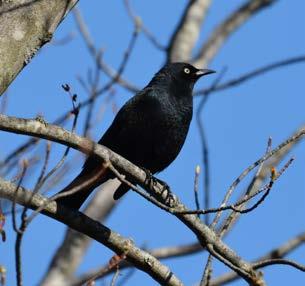
For those of us that don’t often travel out of the area to see “exotic” wildlife, monitoring migrant birds provides us with the opportunity to see a great variety of species without going far. Indeed, all you need to stake out a good piece of habitat and the birds will come to you. So, as usual, my advice is to go outdoors and see what you can find. There is surely no better time of year than October to experience nature in all her bounty and splendor. •









































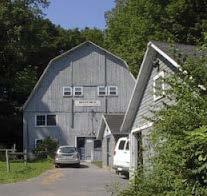

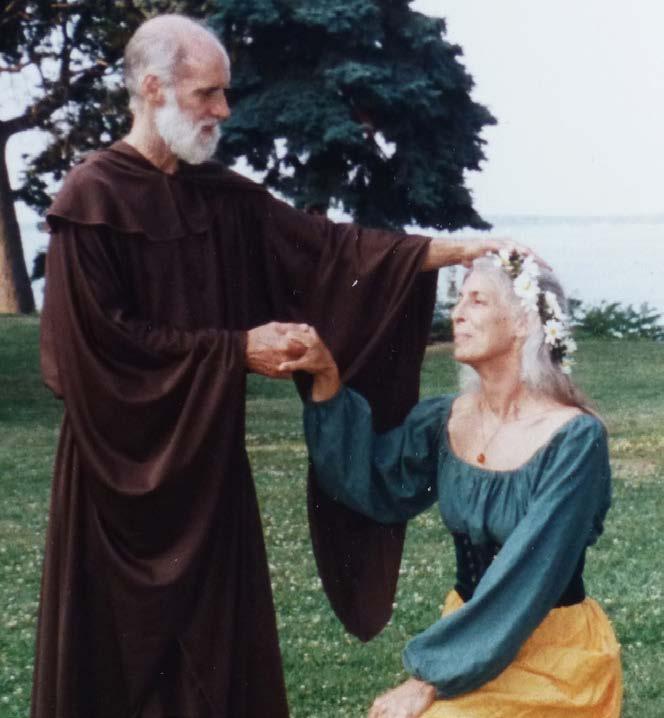

In 1974, Tim and Peggy Spencer Behrendt set off on an adventure. They began a new life in the woods of Cold Brook, NY, without modern conveniences like electricity or indoor plumbing. These are excerpts and reflections from Peggy’s journal chronicling their adventures and also her childhood memories growing up in Westmoreland.

I have a habit of journaling events, ac complishments, and observations at the end of every day. If I don’t, I have a sense of loss – a day of my life will be lost for ever because it will be forgotten. When I randomly read old entries, it’s like a visit with an old friend or relative. The mem ories return, some with pain, some with pleasure, but all with insight and learning. Occasionally, I look for valuable informa tion about past events as they relate to the present (particularly health issues), and it is always helpful.




I also like to read other people’s old journals. One I’ve been enjoying is Rural Hours published in 1850 by Susan Feni more Cooper, daughter of James Fenimore Cooper, both of nearby Cooperstown. (James wrote Last of the Mohicans and other popular adventure stories set in New York State.)
She writes of early Autumn in Cooper stown: “The goldenrod is a fine, showy plant in most of its numerous forms…

one with a pyramidal head has fragrant leaves. The larger and more showy kinds seem more abundant in the valley of the Mohawk than upon our hills. Still, they are common enough here, lining all the fences just now.”

Just north of the Mohawk, our mead ows of goldenrods have passed their mo ments of sunny glory providing late season sustenance to bees and monarch butterflies. Now they sport beards of silvery white sprinkled with stars of white and purple asters. A few moments of the old splendor returns when morning sunbeams shimmer through morning mists, and all be comes briefly golden once again.
The wild apple trees in our valley are abundant with irresistible fruit in lovely hues of rosy red. We breath deeply of their fragrance and the pleasant musk of leaf decay on our bike rides, and it’s tempting to bring home far more apples than we can eat. The instinct to gather and hoard is hard to resist, but we must! We still have 10 gallons of dried apples from past years,
and too many buckets of fruit in the root cellar invariably become buckets of com post with just the two of us eating them. Fortunately, now fresh organic apples are readily available to purchase almost all year.

Before, we had a gas oven where we could dry them quickly on stainless steel cookie sheets. I remember our cottage ceiling full of old window screens hanging between the rafters loaded with carefully peeled and sliced apples, drying on cotton cloths. I would hope for cool weath er,


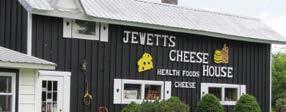


to fire up our wood stove and thus get them dry before they got too dusty.



Susan Fenimore Cooper wrote: “The ceiling of a farm-kitchen… is often a pret ty, rustic sight; all kinds of things hanging there on hooks or nails driven into the beams; bundles of dried herbs, strings of red peppers and of dried apples hanging in festoons, tools, golden ears of seedcorn ripening, vials of physic and nos trums for man and beast, bits of cord and twine, skeins of yarn and brown thread just spun…”
We aspired to the independence and self-sufficiency of the farm life she describes when we began our vegetar ian homestead in September 1974. We worked hard to improve our soil and grow as many food crops as possible. We built our house out of scrap wood. I made quilts out of scrap fabrics and patched holes in rummage sale clothes we purchased. We scrimped and took on extra jobs to buy land that would give us enough dead wood to heat our house, then expanded that to protect the woods and water sources around us from the pollution of civiliza tion and the war on wildlife.
But I feel like we were chil dren at play when I read about self-sufficiency almost 200 years ago.

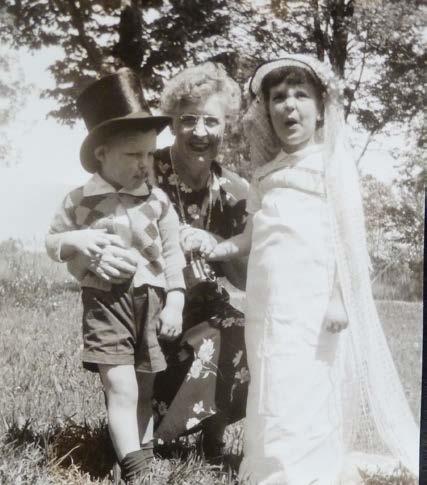

Ms. Cooper writes: “The food of the family was almost wholly the produce of their own farm. They rarely ate their poultry; the hens were kept chiefly for eggs (which were reserved for sale), their geese for feathers. There was a good deal of spinning done in the family; all the yarn for stockings, for the cloth worn by the men, for the woolen dresses of the women and all the thread for their toweling. Almost all the cloth
ing of the family, bedding and toweling was home-made. Very few dry goods were purchased by them …a young woman who knows how to spin and weave can dress herself for twelve dollars a year.”


Now we have an incredible variety of fabric and fashion options. Tim and I had a hippy/patched clothes period in the 1970s, although our patches weren’t simply dec orative; they covered holes and tears. This was (and is) important


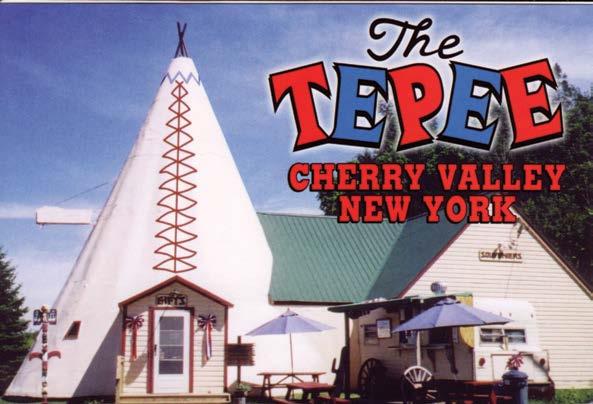


because clothing holes are an invitation to painful bug bites here in the Adirondacks. If it’s too cold for the bugs to be out, it’s too cold for us to have drafty clothes! It amazes me that nowadays people pay good money to have non-functional holes in new clothes.
I also enjoyed wearing the simple col ors, skirts and style of Amish women, and for dress-up occasions or church, I drew on classic Victorian styles with full skirts and blouses of “trunk rumpled cotton” (ac cording to the old J. Jill catalog’s attempt to glamorize “wrinkled”). I liked the idea of it because it conveniently suited my limited storage and ironing capabilities. When we could finally afford a romantic garment from that catalog, I was absolute ly thrilled!





Lately, I just like to be comfortable and practical wearing jeans and a hooded t-shirt with waterproof shoes and socks pulled over the pants legs (to prevent ticks from crawling up). The hood comes in handy to protect the back of the neck and ears from cold temperatures, mosquitoes, no-see-ums and deer fly. In summer, we wear straw hats with veils of “graceful sea foam green or earthy obsidian” (which is how J. Jill might have described our green or black bug hats). I am convinced howev
er, that decorative veils on women’s hats historically served an important survival function when bug repel lents weren’t very effective or pleas antly fragrant.
Playing “dress-up” is common enough in childhood and some times flows into adulthood in many families. When I was an adoles cent in the 1950s, the popularity of the musical “South Pacific” re sulted in an interest in hula skirts at Halloween. I think they were made of dozens of thin, plastic streamers hanging from an elas tic waistband. “The Mikado” (a comic opera satirizing 19th cen tury British society), was likely an earlier costuming influence, as I observe in an old photo that Tim’s mother looks like a pretty Asian girl with other Mikado-ish characters. My own photo album shows my British Grandma Spencer having fun posing with my older brother and sister as an old-fash ioned bride and groom.
Last year, Tim and I drove through down town Poland early Halloween night and were totally delighted to see the sidewalks bursting with strolling families in colorful, creative costumes and little booths set up
in front of some homes offering special treats or entertain ment! To see this wholesome, community festival after the isolation of the COVID pandemic melted our hearts.

At Shawangunk, blue jays, chipmunks, or bears are daily trick-or-treaters but quite often, young family members grace us with a friendly visit in amusing costumes at Halloween. Whether animal or human, I


to offer something healthy; fresh fruit, crackers, a $2 bill…
Since last year, we’ve had a friendly black cat who naturally dresses appropri ately to enhance our October decorations. We adopted Ink (Ink-a-Dink) from the Her kimer Humane Society. She was sneezing, had runny eyes and looked unappealing. I was starting to feel stressed as I’d been there for over an hour unable to choose
which adorable feline I should adopt to be a companion to our pretty, year-old calico cat, Eva. (Eva is named after Tim’s high school classmate, Eva Lynd, who became a movie star.)
Finally, a skinny little black kitty crawled on my lap, purred and refused to budge.
I realized then that I didn’t have to choose, I had been chosen. So, she and her cold medicine came home with us. Still, I was very worried that she and Eva might not get along which could make living with them in our little cottage a nightmare. But Ink-a-Dink’s innate friendliness won over even somewhat aloof Eva after only a few days of hiss ing. I just let them work it out and they have become best buddies, sleeping, playing together, and showing concern for each other on our morning walks, when one disappears in the bushes a little too long.
Tim and I have never needed to wait for Halloween for creative costuming, since we often per formed at weddings, church ser vices and concerts because of our careers as minister and musician. Having had a certain measure of self-sufficiency by living off the grid on our own land (such as the Cooper stown farmers of the 19th century had) has helped us feel freer to be a bit eccentric. Halloween gives us all a socially ac ceptable opportunity to play and be un constrained by fashion or function. But experimenting with costuming in daily life can be a fun way to explore different parts of our personalities and express our life styles. •
This month the Shawangunk Nature Preserve will offer the following workshops which only require a materials fee. Please register at least a week before the class. Call: 315-826-7405 and ask for Peg.

Saturday October 15, 1pm
Carolyn Gaylord will show you how to create an original birthday card and a Christmas card. Use your imagination and the materials provided to personalize your design. Materials: $3 per card.
Meet at 217 Shawangunk Rd. Cold Brook, NY (Whispering Pines)
Saturday, October 29, 10am – 1pm
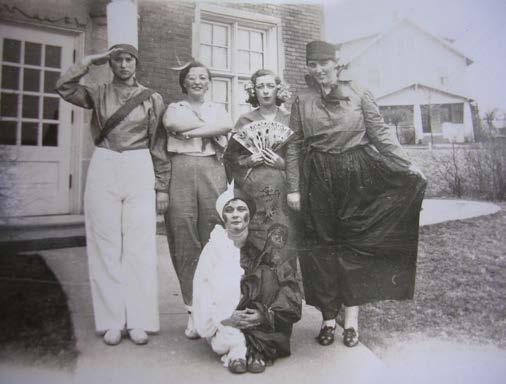

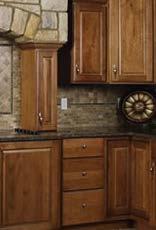

Make a unique vessel for holding a plant or mis cellaneous tools in your home using a hard-shell gourd. You'll have the opportunity to chip carve a unique spiral and/or a Native American style turtle using a hand gouge (stop cuts and cutting techniques) or a Dremel. Bring your own hand gouge (1/4" or 3/8" with a #9 sweep) or Dremel, if possible, or take turns using what we have. Bring a piece of rubberized shelf liner, cut-protective gloves with a secure grip and a mask for gourd dust. Materials $20.
Meet at 255 Shawangunk Rd., Cold Brook, NY.

Preserve is a deep ecology, forever wild, 501©(3), learn ing and cultural center. Tim and Peggy still live there and can be contacted through their


This fall vegetable may look like dill while growing.

Welcome our new roofing advertiser. See page 44.
Peggy quotes this famous writer Susan ____ Cooper.
This is the season of ___ in the life of birds.
Sharry got hooked on the cider slushies this year at ___ Orchards. See page 9.
Call ____ Tree Service to safely remove dead or problem trees. See page 52.

There is a great lineup of events at this local college.
Mohawk Valley Girl takes a ride on this railway.
1. This “woman before her time” will be inducted into the Oneida County Historical Hall of Fame this month. “Bea” ____.
2. Tour this historic mansion in Lyons Falls this holi day season! See page 40.
3. The acronym of this popular toy sounds much more fun than its actual name: Non-Expanding Recreational Foam.
Suzie shares a recipe for ___ & ginger soup.
Gary VanRiper often writes about this ADK denizen.


This rocket could be on its way to the moon!
People love the Mohawk Valley because of its____ seasons.

No longer a sole proprietorship.



Shop distinctive handcrafted pottery at ____ Arts next to Butternut Barn in Richfield Springs. See page 45.


What remains after enjoying this sweet autumn treat (besides the husks).
Crossword Puzzler:

EVERYONE THIS FALL AT FENIMORE!
Ages 19 and under, those receiving SNAP benefits, and more! Visit: FenimoreArtMuseum.org/free


On view through December 31
Sponsored in part by Nellie and Robert Gipson. Photograph by Denis Defibaugh ©️ denisdefibaugh2022

September 17 – December 31
The exhibition was organized by Photographic Traveling Exhibitions, Los Angeles, CA. Elliott Erwitt (American, Born 1928); USA, New York City, 1974; Gelatin Silver Print.
Tales from the Rockabout Hills: Paintings by D. Michael Price

September 17 – December 31 Painting by D. Michael Price.
September 21 – December 31
(detail) Gardening by the Lake. Mary Michael Shelley. Painted woodcarving.
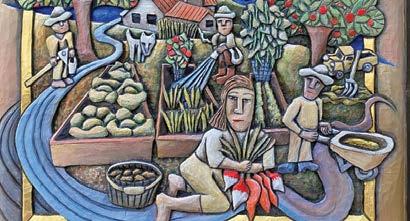
October 1 – December 31
Puffing Billy, 2022, painted wood, 14” x 31” x 22
5798 ROUTE 80 | COOPERSTOWN, NY HOURS THROUGH OCT 10: OPEN DAILY, 10AM–5PM. OCT 11–DEC 31: OPEN TUES–SUN, 10AM–4PM (CLOSED MONDAYS, THANKSGIVING, AND CHRISTMAS)

I love trains! I like to take Amtrak when I want to actually get somewhere, but even more so I love an old-fashioned scenic railway. I had been interest ed in Richfield Springs Scenic Railway since I first heard about it a couple months ago and I was delighted to be able to go on one of their Sunset Rides on a recent Friday.
The railroad is the former Lackawanna Railroad Richfield Springs Branch and operates within Lackawanna Trail Park. The railroad is owned by Ben Gottfried, who purchased it in 2009. The trains are technically operated by the Utica, Chenango and Susquehanna Valley Railroad established in 1868.
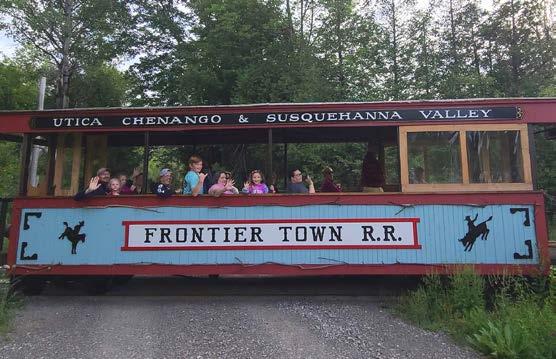

My husband, Steve, and I recruited our friends Kim and Rob to share the treat with us. We packed some drinks and snacks, as the Facebook page invited us to do, and headed down Route 28.





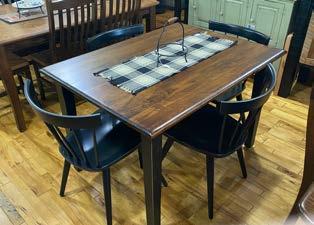
I soon regretted trusting Google Maps. The railway is actually very easy to find: you take 28 to McKoons Road, and the railway is not far after the turn. Austin Joyce the engineer, told me he tells folks to take the first left after Mr. Shake and look for the Newark Milk sign. I had noticed the sign when Google had us drive right by the turn!
We parked in front of the Newark building. I looked at the little museum inside the building but was more interested in crossing the street to check out the train. I could not see the train from the road because it was hidden by the South Columbia train shed.
The cars are originally from Frontier Town. There are two, one with benches and one with wicker chairs. We picked the wicker chairs. Steve and I sat in two chairs facing each other, so I rode backwards on the way out and forwards on the way back. Kim and Rob chose two chairs similarly situated across the aisle.
Erin Dugan and Theodore Schaefer, the conductors, introduced them selves before we set out. Both are friendly and knowledgeable. We enjoyed hearing their commentary and asking them questions.
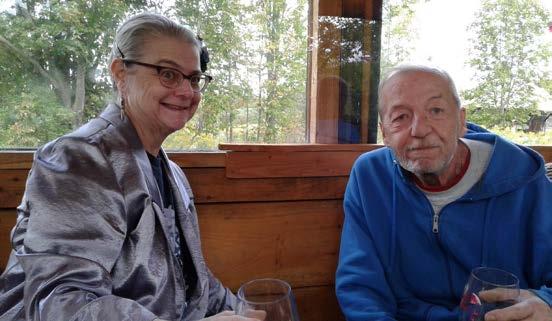
They pointed out the Semaphore lights, which are not original but are



period correct. The signals


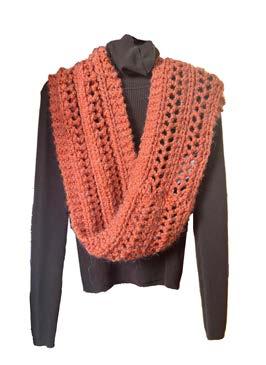




I era. Less period but more

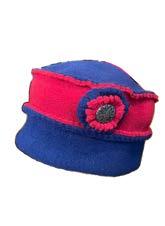
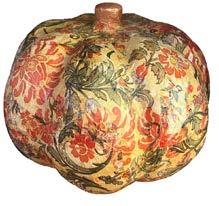


Oldsmobile
Erin pointed out fun sights along the way like a beaver dam. When the tracks crossed the road, Theo dore had to jump out and hold a red flag to stop traffic. Erin told us to be sure to wave at him. I also wanted to get a picture. At one crossroad, a motorist had stopped and gotten out of his truck to take a picture of us. I tried to get a shot of him getting a shot of us, but alas was unable. Later, Erin emailed me some pictures she had taken which included Theodore with the flag. That’s one for the blog!
We enjoyed ourselves so much we took the ride twice. They let you do that on the same ticket on the Friday Sunset Rides. On Saturdays, the railroad offers Nature Discovery Rides with the option to hike the western end of the trail.
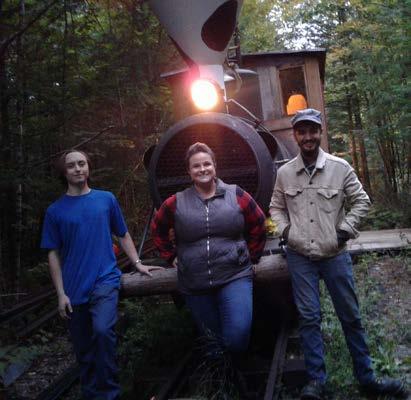
Upcoming excusions include Halloween rides and a Holiday “Colorglo” Train in December. I am personally hoping to catch the Halloween ride, but do not rule out also going again in December. •

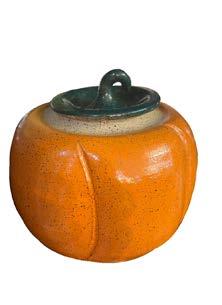

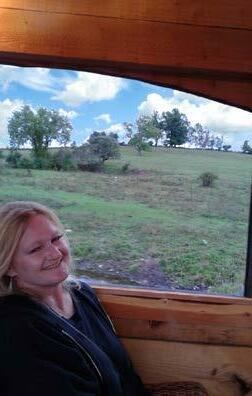

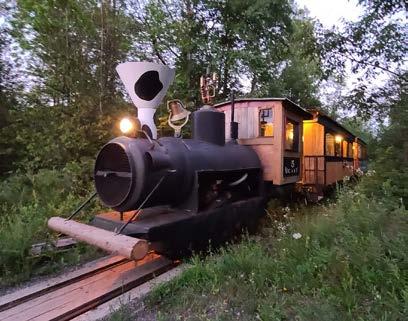
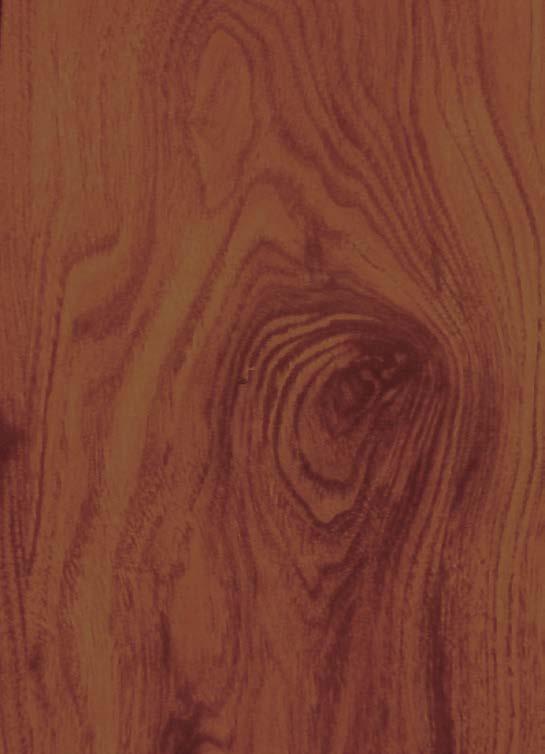


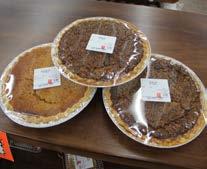



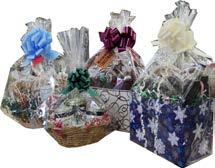
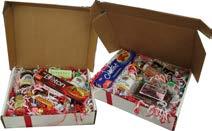





Hometown/current town: New Hartford, NY
Instrument: Voice is primary instrument, violin, and piano
Age when began music: 7 Education: BM Music Education, Boston University; MM Music Education, Boston University
Current employment/position: Music Teacher, Whites boro Central School District
Collaborations: Member of B Sharp Musical Club, recently served as Recording Secretary. Member of Oneida County Music Educators’ Association; honored to conduct the El ementary All-County Chorus in both 2013 and 2022. Be sides teaching in Whitesboro, taught at Oriskany CSD and Utica CSD. Taught Kindermusik at The Piano Lab in Chad wicks, NY; taught private lessons at her home since 2006; and has sung for many years at area Catholic Churches, especially St. Joseph & St. Patrick’s Church and St. John the Evangelist. Currently focused on her new position at Westmoreland Road Elementary as the General Music/ Choir/Strings Teacher.

Influences: Everything I know about singing came from Lauralyn Kolb. In music education, my colleagues are a con stant source of inspiration, as well as a special professor, Dr. Sandra Nicolucci from BU.

I have found that my favorite “instrument” to play is the CHOIR!



Where were you the night of July 20, 1969? If you were like me, you were staring at your television and the grainy black-and-white image of a man from Earth as he slowly climbed down a lad der, paused for a moment on a platform at the bottom, then carefully placed his left foot onto the surface of the Moon. At that historic moment, Apollo program astronaut Neil Armstrong became the first person to set foot on another solar sys tem body. NASA estimates at least 650 million people worldwide were watching the live broadcast. A total of 12 astronauts landed on the surface during six landing missions. The last footprint was left by astronaut Eugene Cernan on December 14, 1972, and humans have not returned to the Moon since then. But after 50 years, that is about to change. Meet NASA’s Ar temis program!

Artemis is an exciting program with ambitious goals: land astronauts on the Moon, establish a base camp and infra structure to support surface operations and exploration, build a lunar orbiting station named Gateway, develop new technologies and gain experience that will eventually lead to sending crewed mis sions to Mars. To accomplish these goals, NASA is working with industry, interna tional partners, universities and others. So far the program is divided into three key missions, and the first is well underway. In recent months, photos of a huge burnt
orange colored rocket with two small er white rockets at its side, and a bright white nosecone on top were often in the news. They are the major parts of the Artemis 1 mission. Together the orange rocket and twin boosters are the Space Launch System (SLS), the most powerful rocket in the world. It stands 322 feet tall, weighs almost six tons fully fueled, and provides 8.8 million pounds of thrust at launch. Inside the white nosecone is the capsule-shaped Orion spacecraft and at tached Service Module. Orion can carry up to four crew members into deep space. Its onboard systems include life support for the crew, communications, and ther mal protection to protect a crew all the way from launch to re-entry, landing and recovery. The Service Module was built by the European Space Agency and pro vides air, water, propulsion and maneu vering capability, solar panels to generate electrical power.

After launch of the Artemis 1 mission from Kennedy Space Center, Orion and its Service module separate from the SLS rocket, marking the start of a 4-day trip toward the Moon. During approach, the trajectory changes, sending Orion into an oval orbit that takes it close to the lunar surface then out 40,000 miles beyond the Moon – the furthest a human-rated space craft has ever traveled away from Earth. The Apollo era spacecraft flew only 60 miles above the surface.
Artemis 1 is a full systems technolo gy test and demonstration mission, with no crew members onboard and four pri mary objectives. The first is to test all systems, processes, flight operations teams, and facilities from pre-launch to recovery. The second is to test the new design heat shield that protects Orion as it returns through Earth’s atmosphere at an astounding 25,000 mph and temperatures up to 5,000 degrees Fahrenheit! Third is retrieve Orion after splashdown in the Pacific Ocean off the coast of California where a recovery ship and crew will be standing by. And finally, accomplish oth er objectives such as radiation testing, onboard experiments, deploy 10 small satellites, and imaging.
As of this writing, Artemis 1 is on the launch pad waiting for liftoff. Upcom ing launch opportunities are throughout October and into November so stand by. For information and status updates during the almost 40 day mission, visit the www. nasa.gov/artemis-1 website.
Wishing you clear skies! •

 Hanny’s Voorwerp. Image Credit: NASA, ESA, W. Keel, Galaxy Zoo Team
Hanny’s Voorwerp. Image Credit: NASA, ESA, W. Keel, Galaxy Zoo Team

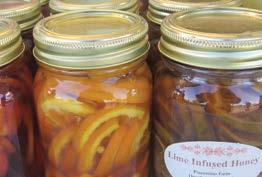

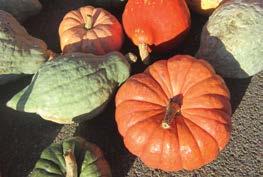


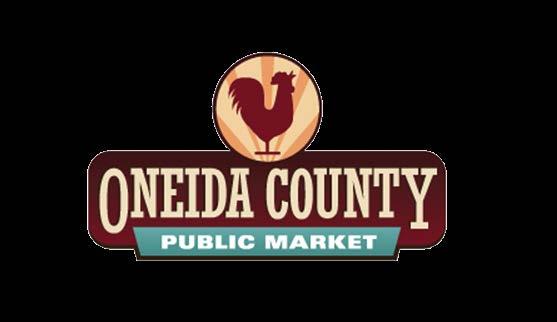
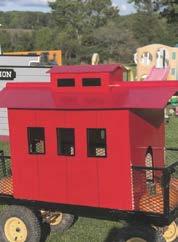


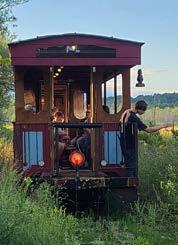

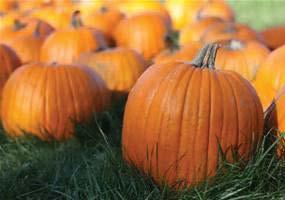




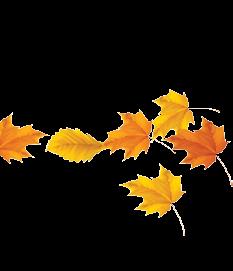


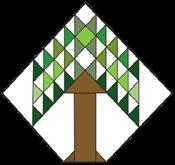



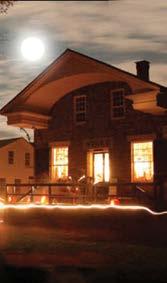



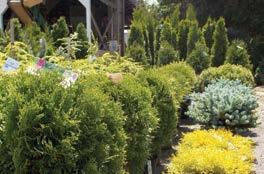





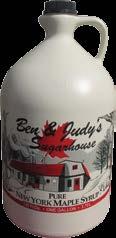







through
at the

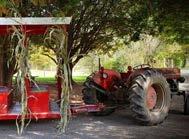



the

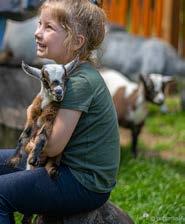
10am-5pm,

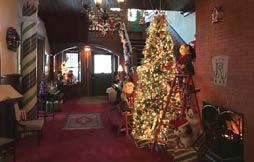

10am-1pm,


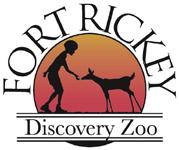

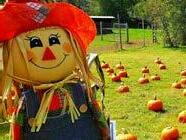
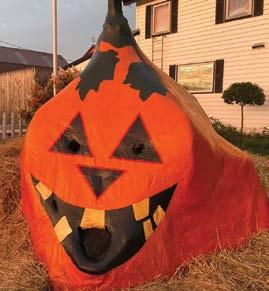

North Star

Thursday, October 20, 5 p.m.
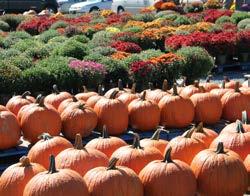
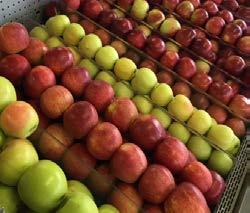

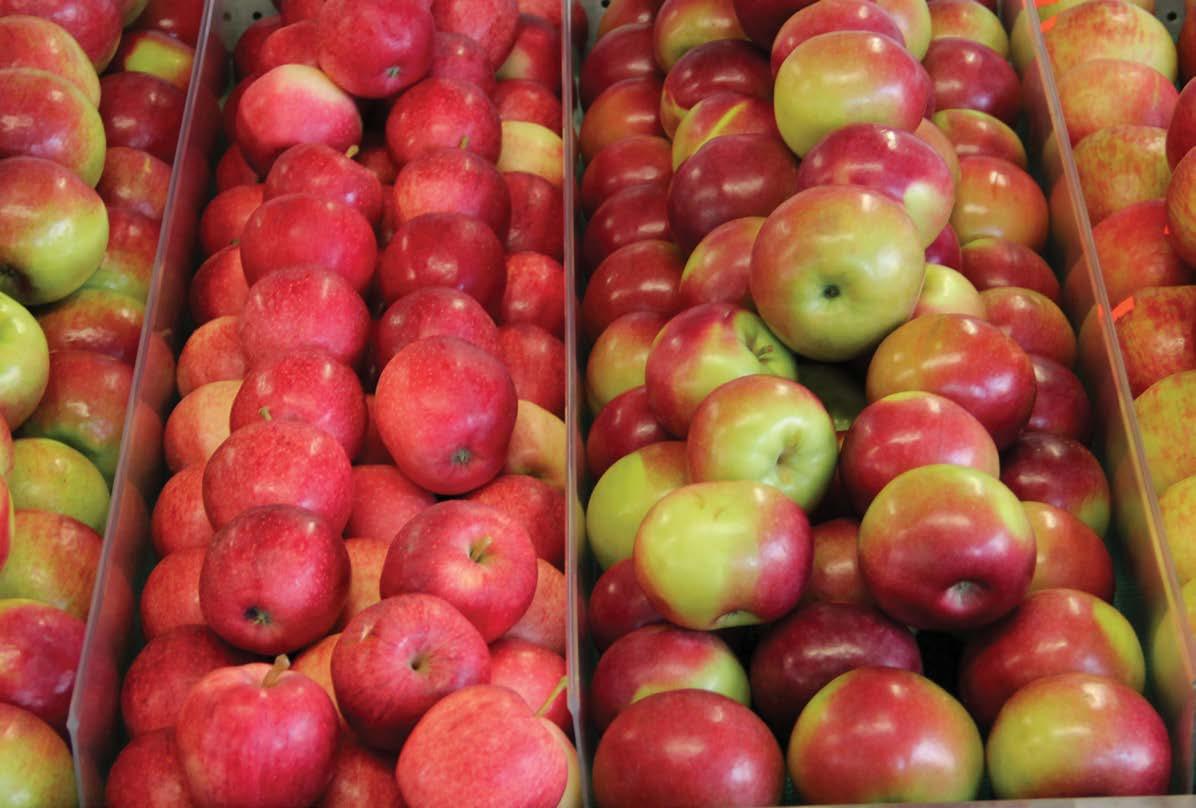
Free for Members, $10 General Admission

Artist Lecture with Lesley Dill | October 20, 4 p.m.


Poetry Night | November 12, 7 p.m.
For more information related to Lesley Dill, Wilderness: Light Sizzles Around Me, visit mwpai.org.
exhibition is sponsored by Steven and Dorian Critelli in honor of Delores Y. Critelli, and by

and

Wilderness: Light Sizzles Around Me is organized and toured by
Davenport, Iowa.
Tuesday through Saturday, 10 am. to 5 p.m. | Sunday, Noon to 5 p.m. | Closed Monday
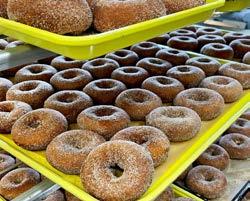
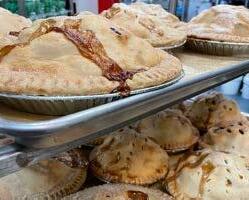

Lesley Dill, Omnipotence
,
paint on fabric, wooden yoke, and shoe
Hayrides Sat & Sun through Oct. 23, 11am-3pm

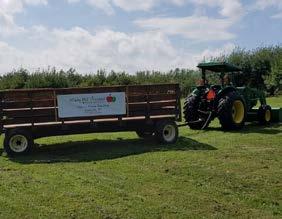
Moonlight Mazes: Sept. 30, Oct. 7 & 14

U-pick pumpkin, U-pick Indian corn, indoor straw maze, and kids’ outdoor play area.
(315) 737-7949
3295 State Route 12, Clinton
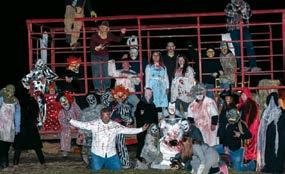
Fridays and Saturdays through Halloween, 7-11pm
3851 Wood Creek Rd., Rome
Facebook: Wood Creek Hallow
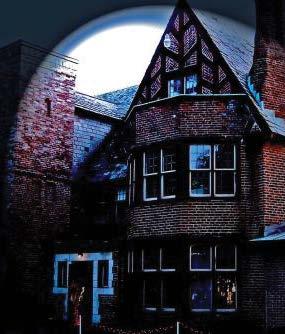
Trick or Treat Street, a Haunted Trail, storytelling, face painting, crafts, tarot card reading, and a bounce house, food & beverages.
Fri. & Sat., Oct 7-8, 14-15, 6pm

Rome Art & Community Center (315) 336-1040
308 West Bloomfield Street, Rome www.romeart.org
Intense indoor Halloween spectacle. Subliminal, demented, original style walk-through horror attraction.
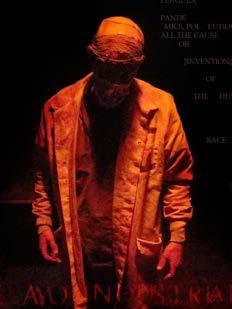

Fri., Sat., & Sun through Oct 30th & Oct. 31st.: 6:30-10:30pm
530 Harbor Way, Rome www.cayoindustrial.com

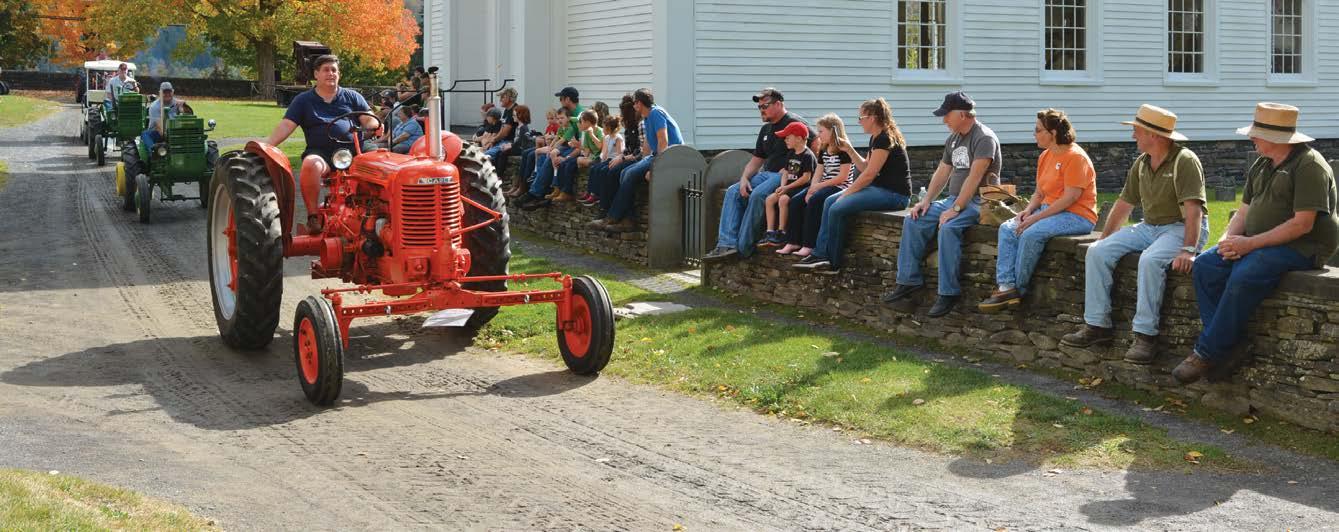





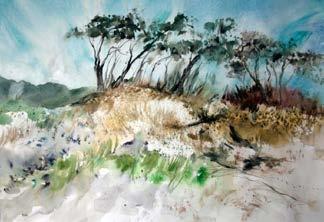







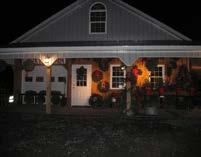
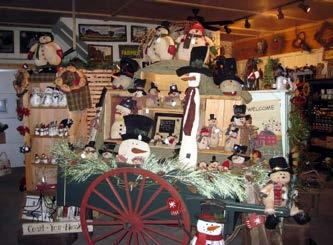
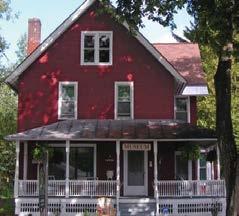


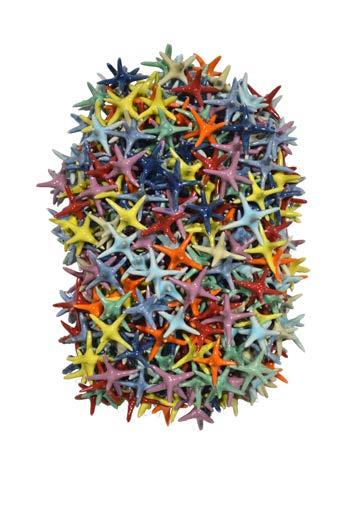

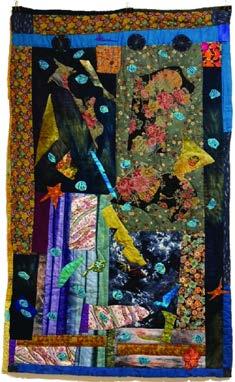


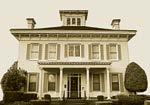



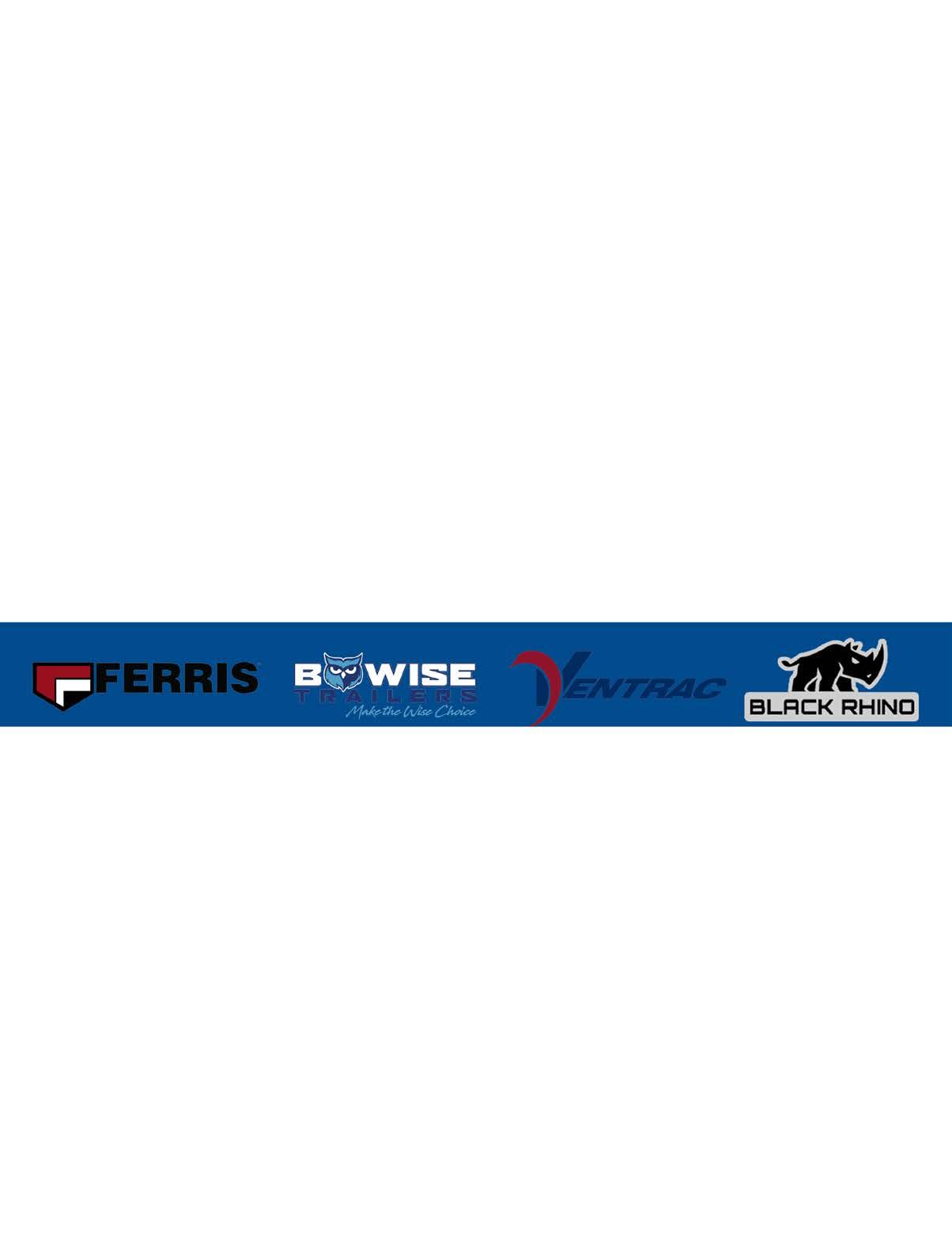
Is there any better time of year than October? The cooler temperatures are a welcome change from the summer’s heat. The later sunrise and earlier sunset mean shorter days and few er working hours on the farm. The autumn colors bring leaf peepers from near and far, and remind us just how beautiful Up state New York truly is.

Our hay season is long over, and we have a barn full of round bales to show for it. Chickens are all processed and tucked away in freezers. It is the time of year I fondly remem ber my grandmother’s basement larder, stocked to the brim with glass jars of canned tomatoes, bread & butter pickles, green beans, and beets—the very definition of bounty. October brings a tremendous sense of accomplishment.


Our sheep and goats are looking healthy and well-fed, ready to give birth in a few short months. Our wood shed is stacked


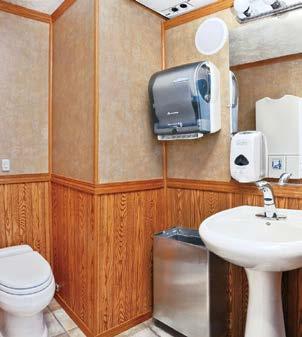




with well-seasoned firewood, enough to carry us through a long, bitter winter. And we will soon have the barn cleaned out and ready for its winter residents. October also marks the calm before the storm.
This month represents an important transition period here on the farm—one that I did not always use to greatest advan tage. It is the perfect time to review and plan; review what we did while it is still fresh in the brain; change what didn’t work, and set in stone the things that did. Generally speaking, we end up tweaking most everything!

To celebrate both the bounty of the farm and prepare for the winter to come, I start cooking in earnest. Cooking dinners is something that rather goes by the wayside during the summer. By the time October rolls around, the whole family is tired of cold cereal or frozen pizza.
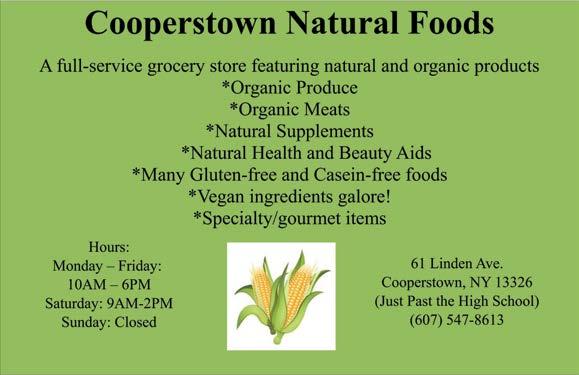
I recommend roasting a whole chicken for dinner one night and then simmering the bones to make stock for use in the fol lowing recipe for dinner the next night. It is perfect October nourishment!:

7-8 cups chicken broth
2-3 lbs carrots, peeled and sliced
2 garlic cloves, diced fine
2 medium onions OR 3 leeks, chopped
1-2 yams or sweet potatoes, peeled and cut into 1” cubes
4 stalks celery, chopped
1 3” piece of ginger, grated
4 tablespoons butter
1 tsp nutmeg
Salt & pepper, to taste

Heavy cream, parmesan, or croutons (optional)
Instructions: Bring stock to a low simmer in large soup pot. Sauté vegetables with ginger and nutmeg in butter for approximately 15 min utes. Transfer vegetables to hot stock, cover, and simmer over low heat for approximately 30 minutes or until tender.
Puree mixture using submer sion blender or regular blender.
Add salt and pepper, as needed. Serve in soup bowls and finish with croutons, a splash of heavy cream or grating of nutmeg or parmesan (if using.)
Leftovers freeze very well! •
Suzie Jones and her husband, Peter, own Jones Family Farm in Herkimer. Together, with their chil dren, they produce specialty goat cheeses and gelato. Find them at local farmers’ markets and online at www.anotherjonesfamilyfarm.com
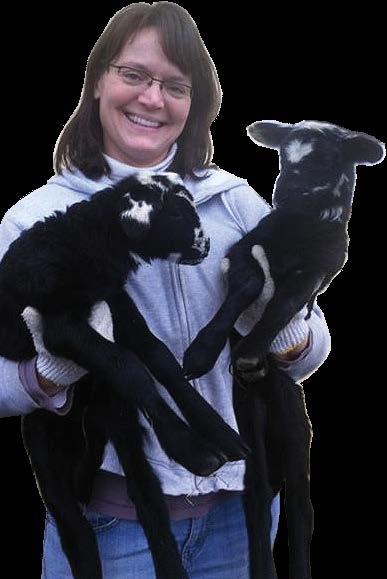
I’ll never forget the first time I was paddling on Moss Lake in early autumn at dawn and found the glass surface of the water littered with feathers from a Common Loon. There were hundreds of them in all shapes and sizes, many with white dots. Was the bird sick? Attacked? Was there more than one loon involved?


Later I learned it was the season when the Common Loons that breed in the Adirondacks were molting, getting ready to begin their migration to open water along the east coast. The adult loons are first to leave, followed soon after by their young.

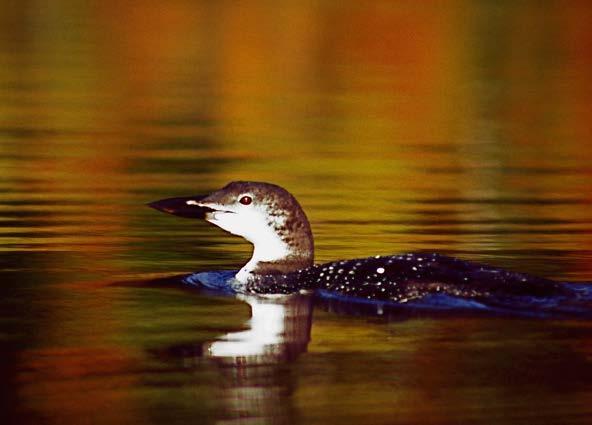
Have you ever watched a loon take off - beating its wings, with legs churning - sprinting across the surface of the lake? Since loons need a water runway at least the length of 1/3 of a football field to lift off, it is easy to understand why it is so critical they are away before ice forms and they become trapped, unable to leave.
Once airborne, loons are tremendous flyers, capable of traveling hundreds of miles at a time with speeds up to 70 miles per hour!
Research via satellite telemetry and bird band recover ies has shown our breeding loons head for Long Island, the Cape in Massachusetts, New Jersey, North Carolina and as far south as Florida’s Gulf Coast. I have personally come across a Common Loon that was ill and stranded on a South Carolina beach. However, if you ever see a loon on a coastal beach it is most likely resting, rather than sick or stranded, so
Loons need a water runway at least the length of 1/3 of a football field to lift off














Sometimes loons are fooled by wet pavement and stretches of sand inland and will crash land requiring rescue.
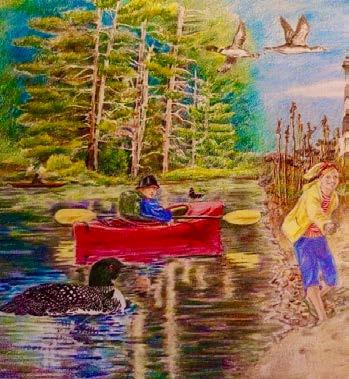
You might not even recognize a loon if vacationing south in the winter. Their plum age is dull and they lose their red eye color. Sea Hag was one description I recall reading years ago of wintering loons on coastal wa ters.

So, early in October you may notice a number of loons congregating together on an Adirondack lake. If you notice hundreds of feathers floating on the surface, don’t pan ic. These are indications that the 600 - 1000 pairs of loons we have in the Adirondack Park are simply preparing to leave us to deal with the snow, ice, and frigid temperatures of our long winter.

A great place to learn more about Com mon Loons that breed in the Adirondacks is The Adirondack Center for Loon Conserva tion. Visit adkloon.org for information. •
Gary encountered a Common Loon that was ill and stranded on a South Carolina beach.










please support Our sponsors, they make this magazine possible
Paca Gardens . . . . . . . . . . . 5
Antiques & Art Westmoreland . . . . . . . . . 18
Attic Addicts . . . . . . . . . . . . . . . . 18
Black Cat Antiques . . . . . . . . . . . . . . 19
Broad Street Flea Market . . . . . . . 19
The Bull Farm Antiques . . . . . . . . . . 19
The Depot Antiques . . . . . . . . . . . 19
The Gallery Antiques at Pinebrick . . . . . . 19
Little Falls Antique Center . . . . . . . 19
Madison Inn Antiques . . . . . . . . 20
Mohawk Antiques Mall . . . . . . . 20
Mohawk Valley Community Market . . . 20
The Potting Shed Antiques . . . . . . . 19
Showcase Antiques . . . . . . . . . 20
Valandrea’s Venture . . . . . . . . . 20
Victorian Rose . . . . . . . . . . . 20
Weeden’s Mini Mall . . . . . . . . . . 20
Whistle Post Antiques . . . . . . . . 20
Nye & Company Auctioneers . . . . . . . . 20
Fusion Art Gallery . . . . . . . . . . . . 40
MWPAI . . . . . . . . . . . . . 41
View Arts . . . . . . . . . . . 38
Fusion Art Gallery . . . . . . . . . . . 40
Azure Arts Pottery . . . . . . . . . . . . 45
Steet-Ponte Auto Group . . . . . . . . . 57
Automotive Repair and Towing Clinton Collision . . . . . . . .
Caruso’s Pastry Shoppe . . . .
Karam’s Middle East Bakery .
Banks
Bakery . . . .
of Utica . . . .
Dick’s Wheel Shop . . . .
Berry Hill Book Shop. . . .
& Lloyd Bookshop . . . . . . . .
Treehouse Reading Room . . . . . . . .
Custom Woodcraft . . . . . . . . .
Knotty By Nature . . . . . . . . .
Candy
So Sweet Candy Shoppe, Utica . . . . . .
RoSo’s Cafe & Catering . . . . . . . . . . .
Willie’s The Original Bagel Cafe . . . . . .
Utica Hemp, New Hartford . . . . . . . .
Cheese
Ed
Delis
Diners
Charlie’s Place . . . . . . . . . . . . . . 15
Riverside Diner . . . . . . . . . . . . 16
Sheri’s Eastside Diner . . . . . . . . . . . . . .
Wendy’s Diner . . . . . . . . . . . . . . 17
Dog Sitting
Barney’s Angels . . . . . . . . . . . . . 24
Doors, Residential & Commercial
JM Door Co. . . . . . . . . . . . . . 46
Collins Aerospace . . . . . . . . . . . . 30
Estate Sales
Attic Addicts . . . . . . . . . . . . . . . 18
The Potting Shed Antiques . . . . . . . . . . 19
Events, Entertainment, and Activities
Cackleberry Castle . . . . . . . . . . . . 37
Cayo Industrial Horror Realm . . . . . . . . 42
Cullen Pumpkin Farm . . . . . . . . . . . . 37
Farmers’ Museum . . . . . . . . . . . 43
Fenimore Art Museum . . . . . . . . . . 29
Florissante Mansion Tours . . . . . . . . 40
Fort Rickey Discovery Zoo . . . . . . . . 40
Goodsell Museum . . . . . . . . . . . . 45
Hamilton College Performing Arts . . . . . . . 10
MVCC Cultural Series . . . . . . . . . 42
Old Forge Tourism . . . . . . . . . . . . 3 Pumpkin Junction . . . . . . . . . 37
Richfield Springs Scenic Railway . . . . . . . 38
Clinton Tractor . . . . . . . . . . . . . 47
Hobby Hill Farm Sales . . . . . . . . . . 48 White’s Farm Supply . . . . . . . . . . . . 56
Farm Markets
Horn’s Family Farm . . . . . . . . . . . 38 Juliano’s Farm and Greenhouses . . . . . . . 8 North Star Orchards . . . . . . . . . . . 41
Oneida County Public Market . . . . . . . . 36 Windy Hill Orchard . . . . . . . . . . . 39
Van Meter & Van Meter . . . . . . . . . . 22
Firewood Delivered
Ridgeline Farms . . . . . . . . . . . . . 13
Enjem’s Flooring America . . . . . . . . . . . 7 Mike’s Floor Store . . . . . . . . . . . . 25
LaBella Flowers . . . . . . . . . . . . 21
CNY Green Bucket Project . . . . . . . . 23
Prince-Boyd & Hyatt . . . . . . . . . . . 46
Ironwood Furniture . . . . . . . . . . . . 31
Jeff’s Amish Furniture . . . . . . . . . . 35
John Froass & Son . . . . . . . . . . 8 Shoppes at the Finish Line . . . . . . . . . 23
Custom Woodcraft . . . . . . . . . . . 12
Garden Centers and Greenhouses
Candella’s Farm & Greenhouses . . . . . . . 13
Casler Flower Farm . . . . . . . . . 45
George’s Farm Products . . . . . . . . . . 38
Green Lakes Home & Garden . . . . . . . 38
Juliano’s Farm and Greenhouses . . . . . . . . . 8
North Star Orchards . . . . . . . . . . . 41
Twin Orchards . . . . . . . . . . . 9
Ed Smith Contractor and Handyman . . . . . . . 52
General Stores
Bonnie’s Country Store . . . . . . . . . . 51
Deansboro Superette . . . . . . . . . . . . . 35
The Artisans’ Corner, Clinton . . . . . . . . . . 32
Between Us Sisters . . . . . . . . . . . . . . 11
Fusion Art Gallery . . . . . . . . . . . 40
Krizia Martin . . . . . . . . . . . . . . 10
Shoppes at the Finish Line . . . . . . . . . 23
The Tepee . . . . . . . . . . . . . 25
Woodgate Pines Golf Club . . . . . . . . 31
Grocery Stores, Co-ops, and Delis
Bosonne’s Sausage . . . . . . . . . . . . . 46
Deansboro Superette . . . . . . . . . . . . 35
Little Italy Imports . . . . . . . . . . . . 24
Olde Kountry Market . . . . . . . . . . . 33
Pulaski Meat Market . . . . . . . . . . . . 52
Lincoln Davies . . . . . . . . . . . . . . . 9
Morgan’s Hardware . . . . . . . . . . . . . 49
Turner Lumber . . . . . . . . . . . . . . 27
Wightman Specialty Woods . . . . . . . . . . . . 48
Vitality Fitness and Wellness . . . . . . . . . . 25
Insurance
HBE Group, Inc. . . . . . . . . . . . . . . . 26
Turnbull Insurance . . . . . . . . . . . . . . 23
The Added Touch Drapery . . . . . . . . . . . 28
Ironwork
Raulli’s Iron Works . . . . . . . . . . . . 25
Alison’s Jewelry & Repair . . . . . . . . . 23
Fall Hill bead & Gem . . . . . . . . . . 12
Goldmine Jewelers . . . . . . . . . . . . 51
Lighting Mills Electrical Supply . . . . . . . . . . . . . 32
Ilion Wine & Spirits . . . . . . . . . . . 45
Brimfield Farm Winery . . . . . . . . . . . . . 28
Prospect Falls Winery . . . . . . . . . . . . . . 35
Trenton Station Liquor & Wine . . . . . . . . 25
Maple Syrup (See Produce)
Sunnybrook Farm . . . . . . . . . . . . 44
Media Weekly Adirondack . . . . . . . . . . . . 25
Monuments & Memorials
Yorkville Memorials . . . . . . . . . . . . . 14
Cooperstown Naturals . . . . . . . . . . . 49
Peter’s Cornucopia . . . . . . . . . . . 33
Nuts
Finger Lakes Nut Farm . . . . . . . . . . . . 51
Towpath Vision Care . . . . . . . . . . . . 22
Paint and Painting Supplies
Urbanik’s Paint & Wallpaper Co. . . . . . . . 51
Inertia PT . . . . . . . . . . . . . . . . .
Pizzerias
DiCastro’s Brick Oven . . . . . . . . . . 15
Primo Pizzeria . . . . . . . . . . . . .
Tony’s Pizza . . . . . . . . . . . . . .

& Judy’s
. . . . . .
. .
Farm . . . . . . . . .
. . . . . . . . . . . . .
.




. . . . . . . . .
. . . . . . . . .
. . . . . . . . .
. . . . . . . . .
Howard Hanna . . . . . . . . . . . . . . 2
Restaurants and Cafés (See also Diners)
Ann St. Deli . . . . . . . . . . . . . . 15
Black Stallion Restaurant . . . . . . . . . . . 15
DiCastro’s Brick Oven . . . . . . . . . . . 15
Gilligan’s Restaurant . . . . . . . . . . . 15
Karam’s Middle East Bakery . . . . . . . 15
Kayuta Drive-In . . . . . . . . . . . . . 15
Killabrew . . . . . . . . . . . . . 16
Ohio Tavern . . . . . . . . . . . . . . 16
Phoenician Restaurant . . . . . . . . . . 16
RoSo’s Cafe & Catering . . . . . . . . . . 16
.
Willie’s

Steakhouse . . . . . . .
and Annie Foods . . . . .

. . . .
Original Bagel Cafe . . . .
Willows . .

Swarey
Shoes
.




